Reveal specifications
Tannoy Reveal is a highly regarded series of studio monitor speakers designed for professional and home studio environments. These monitors are known for their accurate sound reproduction and exceptional build quality, making them a popular choice among audio engineers, music producers, and enthusiasts alike.One of the main features of the Tannoy Reveal monitors is their innovative Dual Concentric driver technology. This unique design integrates the woofer and tweeter into a single point source, allowing for coherent sound reproduction across the entire frequency range. As a result, audio professionals can enjoy improved imaging and spatial clarity, making it easier to pinpoint sounds within a mix.
The Reveal series comes with a wide frequency response, ensuring that both low and high frequencies are rendered with precision. The bass response is deep and impactful, ideal for genres that require a solid low-end. The high frequencies are airy and detailed, catering to the nuances of vocals and various instruments. With well-balanced sound characteristics, the Reveal monitors provide a true representation of audio, making them invaluable for mixing and mastering tasks.
Tannoy has incorporated rear-firing bass ports in the Reveal models, allowing for improved efficiency and reduced distortion. This design feature enhances the overall acoustic performance, enabling the monitors to deliver a more robust low-end without compromising clarity. Additionally, the monitors are equipped with room EQ controls, allowing users to tailor the sound output based on their specific listening environment.
The build quality of the Tannoy Reveal is also noteworthy. Constructed with durable materials, these monitors are designed to withstand the rigors of professional use. The sleek, modern design fits seamlessly into any studio setup while also minimizing resonance and interference.
Connectivity options are versatile, with each monitor featuring balanced XLR and TRS inputs, making it easy to integrate them with various audio interfaces and mixers. Each monitor is designed to provide a reliable performance, ensuring that audio professionals can depend on them for critical listening tasks.
In summary, the Tannoy Reveal monitors deliver a combination of advanced technology, superb sound quality, and professional-grade construction. Whether used in a commercial studio or a personal setup, they offer exceptional audio performance that meets the demands of today's music production landscape. With features designed to enhance accuracy and clarity, the Reveal series continues to be a top choice for audio professionals worldwide.
